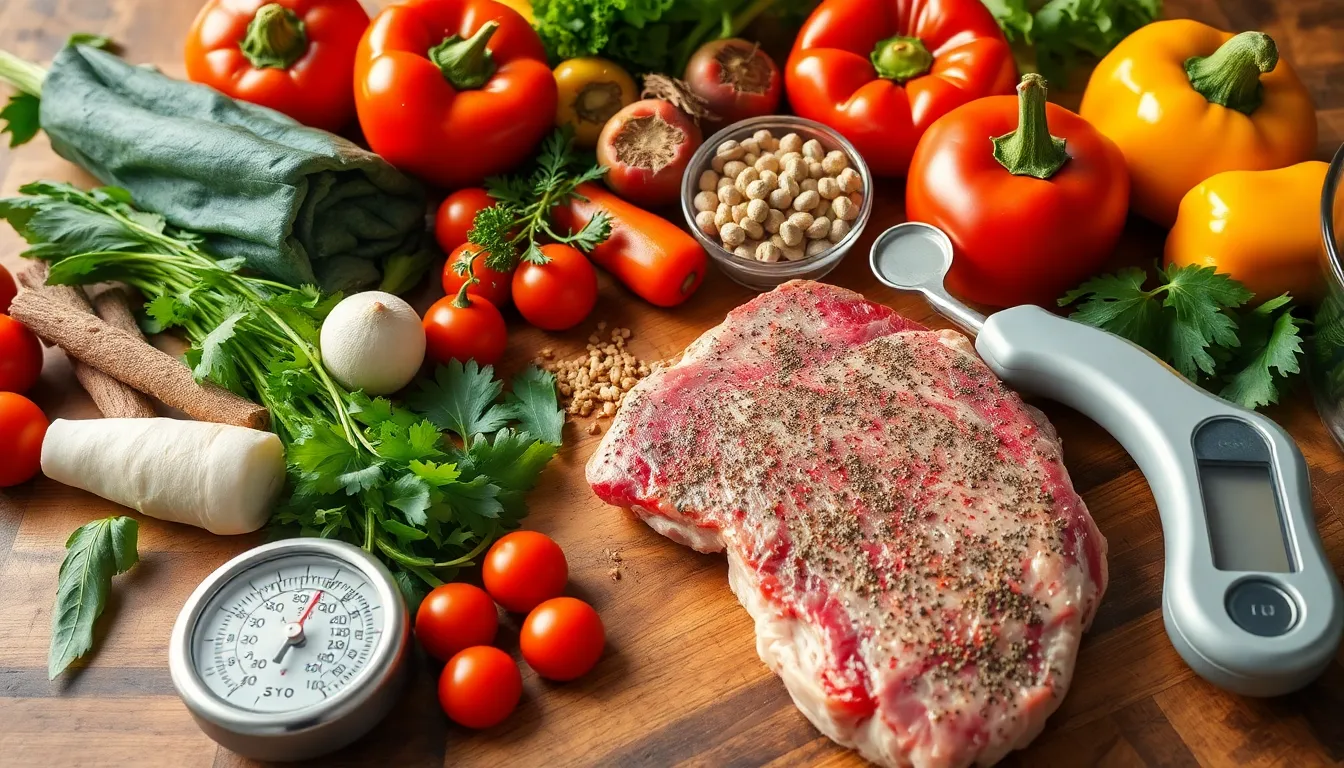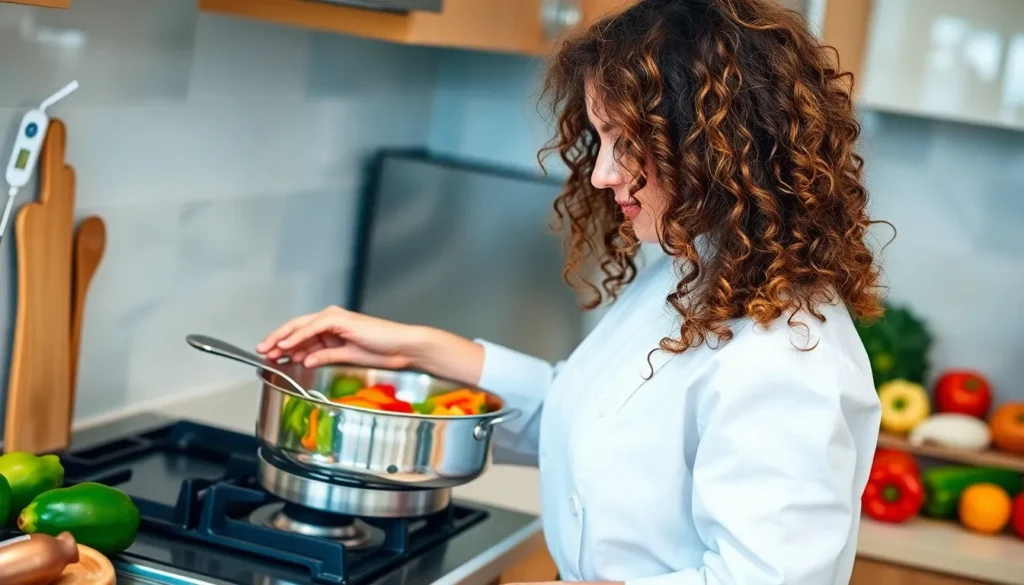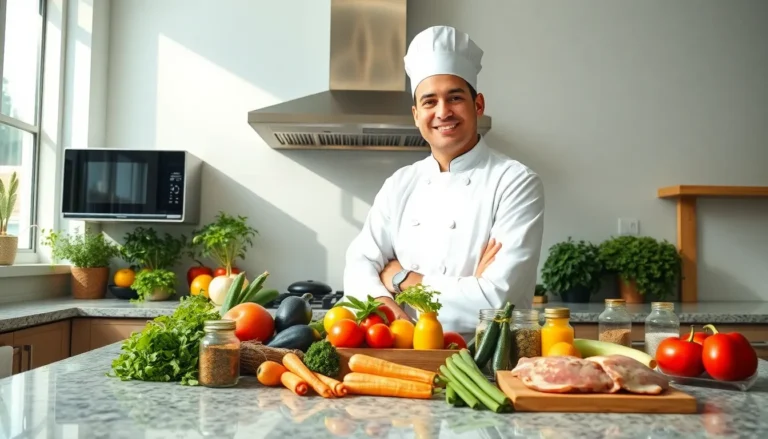Table of Contents
ToggleCooking isn’t just about throwing ingredients together and hoping for the best. It’s a fascinating blend of art and science where chemistry meets creativity. Ever wondered why your soufflé flops or why that steak didn’t sear quite right? Understanding the science behind cooking can transform anyone from a kitchen novice into a culinary wizard—without the need for a magic wand.
What Is Cooking Science?
Cooking science refers to the systematic study of the chemical and physical changes that occur during food preparation. Understanding these transformations enhances culinary experiences, revealing why specific techniques yield desired results.
Heat application influences ingredient behavior. For example, heat causes proteins to denature, impacting texture and flavor. Emulsion methods, such as making mayonnaise, depend on understanding the balance of fats and liquids to achieve stability.
The Maillard reaction illustrates chemistry in cooking, where amino acids and sugars react under heat, creating complex flavors and browning in foods like roasted meats. Temperature control becomes crucial, as different foods require various optimal temperatures to achieve desired results.
Acidity plays a significant role in taste and preservation. Acidic ingredients, such as vinegar and citrus juice, can enhance flavors while acting as preservatives in marinades. Knowledge of pH levels assists in creating balanced dishes.
Understanding ingredient interactions leads to better recipe development. Salt, for instance, enhances flavors and alters the texture of meats through brining. Mastery of these interactions contributes to a chef’s ability to innovate and improve classic recipes.
Moreover, cooking science addresses food safety. Using appropriate temperatures eliminates harmful bacteria, ensuring dishes are safe for consumption. Familiarity with these principles fosters confidence in preparing meals.
In essence, cooking science blends the artistic aspects of culinary creation with a solid foundation of scientific understanding, encouraging cooks to experiment and elevate their cooking skills beyond mere ingredient mixing.
The Importance of Cooking Science

Cooking science plays a crucial role in culinary success. It provides essential insights into how different variables affect food quality.
Enhancing Flavor and Texture
Understanding chemical reactions enhances flavor and texture in food. The Maillard reaction develops rich, complex flavors during cooking. Applying heat causes proteins and sugars in various ingredients to react, leading to browning and improved taste. Acidity also plays a vital role; it balances flavors and enhances freshness. Experimenting with ingredients under different conditions can lead to unique textures, such as a crispy crust on meats or tender vegetables. Knowledge of these reactions encourages culinary creativity and refined techniques.
Food Safety Considerations
Food safety remains a top priority in cooking science. Appropriate cooking temperatures eliminate harmful bacteria, ensuring safe consumption. For example, poultry should reach an internal temperature of 165°F to prevent foodborne illness. Using a food thermometer provides accurate measurements while monitoring cooking processes. Understanding cross-contamination is essential; keeping raw and cooked foods separate minimizes health risks. Proper storage techniques, like refrigeration, also preserve food quality and safety. Overall, adherence to these practices supports a healthier culinary experience.
Key Principles of Cooking Science
Understanding cooking science requires knowledge of key principles that influence food preparation. Heat transfer methods and chemical reactions in cooking play significant roles in transforming ingredients.
Heat Transfer Methods
Heat transfer influences how food cooks, affecting texture and flavor. Conduction occurs when direct contact transfers heat, like when a steak sizzles on a hot pan. Convection circulates heat through fluids, evident in simmering soups or boiling pasta. Radiation involves energy waves, as seen when grilling or broiling food. Each method requires precise control, ensuring that temperatures remain consistent for optimal results.
Chemical Reactions in Cooking
Chemical reactions shape flavor and appearance during cooking. The Maillard reaction develops complex flavors and browns food when proteins and sugars interact under heat. Caramelization occurs when sugars break down, resulting in sweet, rich notes. Acidic ingredients enhance flavors and tenderize proteins, promoting delicious outcomes in marinades or dressings. Understanding these reactions supports better recipe development and elevates culinary skills.
Popular Cooking Techniques Explained
Cooking techniques play a vital role in culinary science. Understanding these methods enhances skills and elevates dishes.
Sous Vide
Sous vide involves vacuum-sealing food in a plastic pouch and cooking it in a temperature-controlled water bath. This technique ensures even cooking, retaining moisture and flavor. For instance, cooking a steak at 130°F for one to four hours produces tender, perfectly medium-rare results. The precision of sous vide minimizes the risk of overcooking, a common mistake in conventional methods. This technique also allows for cooking multiple items simultaneously without sacrificing quality.
Molecular Gastronomy
Molecular gastronomy combines culinary arts with scientific techniques to transform flavors and textures. Chefs utilize methods such as spherification, where liquids form gel-like spheres, creating unique dining experiences. Techniques like foaming introduce unexpected textures, altering the way flavors are perceived. For example, transforming fruit juice into airy foam enhances traditional desserts. Utilizing scientific tools, chefs gain control over chemical reactions, unlocking innovative presentations and taste experiences. This method blends creativity with precision, offering diners a modern culinary adventure.
Understanding the science behind cooking opens up a world of culinary possibilities. By grasping the principles of heat transfer and chemical reactions cooks can enhance flavors and textures with confidence. This knowledge not only improves skills but also reduces the likelihood of common kitchen mishaps.
Embracing techniques like sous vide and molecular gastronomy allows for creativity and innovation in the kitchen. Moreover prioritizing food safety ensures that every meal is not only delicious but also safe to enjoy. As cooks experiment with these concepts they’ll discover that the art of cooking is truly a blend of creativity and scientific understanding.








